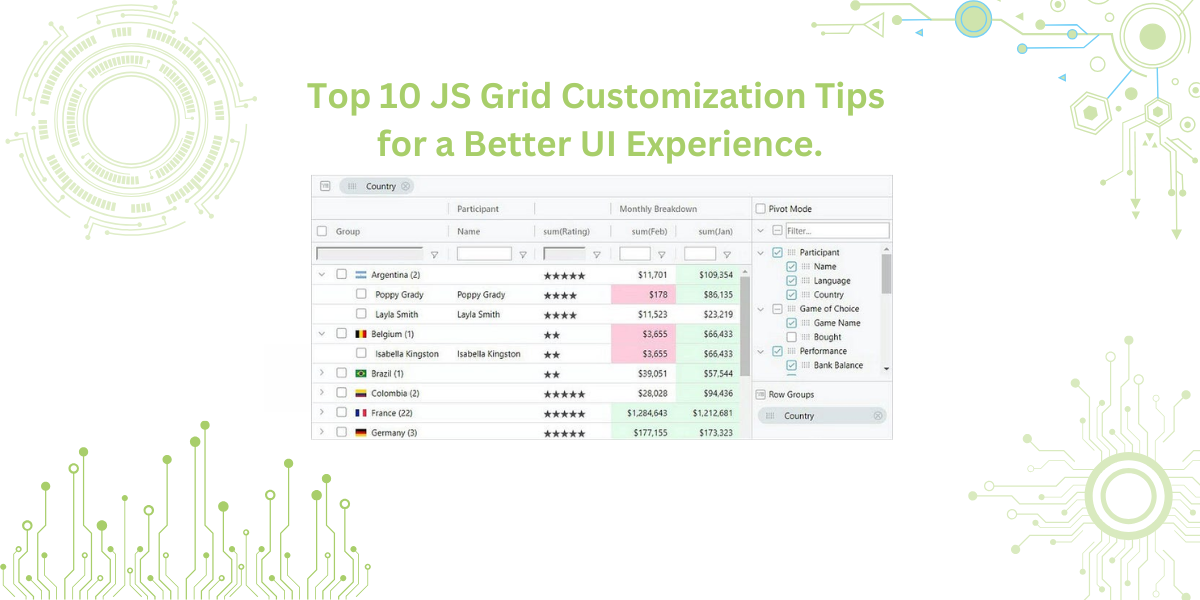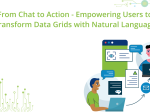Top 10 JS Grid Customization Tips for a Better UI Experience
Grids are pretty much everywhere in web apps. Working with financial sheets, product details, or users? Then you’ve probably used a JavaScript grid.
It makes data look clear and simple. Just helps you view things without the clutter. Easy to manage and quick to read. But here’s the catch – not every grid feels smooth or easy to use.

Some grids freeze up with large datasets or feel too rigid. That’s why tweaking your React JS grid component can really make a difference. A few smart changes can improve speed, make things easier to read, and just offer a better overall experience.
In this guide, we’ll walk you through ten simple ways to improve your grid in React JS. Whether you’re starting from scratch or customizing a pre-built grid in JS, these tips will help. We’ll touch on things like column design, pagination, tooltips, and accessibility. Real-time updates and responsive layouts are also in the mix.
If you’re using tools like Ext JS or any rapid application development software, this gets even easier. It’s a solid way to speed up custom software application development. Whether you’re comparing application developer vs software engineer roles or exploring free application development software, understanding grids is key.
Let’s dive in and improve that React grid.
1. Customize Column Headers
Let’s be honest: if your grid starts with “Column 1” or just “Data,” it’s not helping anyone. Clear, meaningful headers make your grid in React JS easier to follow and way more user-friendly.
Why Column Headers Matter
In any React JS grid component or JavaScript data grid, good labels guide users. They help people scan rows quickly without second-guessing what they’re looking at. Especially in custom software application development, a clean UI can make or break the experience.
Tips to Modify Column Headers
- Use clear names like “Order ID” or “Customer Name” instead of just “ID.”
- Add style where it helps – bold fonts, small icons, or tooltips
- Align smart numbers in the center, text on the left
- Let users rename or hide columns when needed
If you’re building a React grid library or working with website application development software, flexible headers are a nice touch. They make your app feel more polished and interactive.
2. Implement Sorting and Filtering Options
If your app has a lot of data, sorting and filtering really help. They keep everything neat and easy to manage. Users won’t have to scroll forever to find something. It just makes using the app easier.
Why Sorting and Filtering Matter
- Quick scanning – Users can sort data alphabetically or by number with a single click.
- Clear focus – Filters help cut through the clutter, showing only what’s important.
- Better experience – Essential when dealing with finance dashboards or stock tracking.
How to Add Sorting and Filtering
- Turn on column-based filters in your React grid component.
- Add dropdowns or search fields in header rows for easier access.
- Use custom filters for things like dates or specific conditions.
These features are key when working with any grid in React JS. Whether you’re building a JavaScript data grid or a full React grid layout, sorting and filtering make the user interface much smoother. If you’re offering custom software application development or even free application development software, this is a must-have.
It’s one of those things that separates good tools from the best application development software on the market.
3. Grid Editing and Row Insertion
A good grid in React JS should let users make quick changes without jumping through hoops. No one wants to open a pop-up just to fix a small typo or add a new entry. That’s where inline editing comes in. It’s simple, fast, and keeps things smooth.
Here’s what you’ll want to have:
- Inline editing – Users can just click a cell and type.
- Insert new rows – Add new data on the spot without refreshing the page.
- Cell validation – Use highlights or tooltips to show errors right away.
These features used to be limited to expensive, enterprise-only tools. But now, with a good React JS grid component or JavaScript data grid, they’re available to everyone. Whether you’re using free application development software or working on a big custom software application development project, these tools help you build faster.
If you’re thinking about building a React grid library, these are must-haves. They’re part of what makes a great React grid layout feel modern and efficient for any software/application developer.
4. Styling and Theming
How your grid looks really affects how people use your app. A clean, well-designed grid just feels better and makes everything easier to understand. Plus, it helps your app stand out and stay on-brand.
Why Styling Matters
- Keeps the UI in line with your app’s overall design
- Makes data easier to scan and interpret
- Makes your app look clean and easy to use. It feels more organised and better for the user.
Tips for Styling Your Grid
- Colors and Fonts – Stick to your app’s theme so everything blends well
- Spacing – Add some padding and margins for better readability
- Interactive Feedback – Show hover effects or row highlights to guide users
5. Pagination Techniques
Showing thousands of rows at once? It usually doesn’t work well. Everything loads slowly, and users can’t find stuff easily. Pagination makes it simpler. It keeps things clear and easy to follow. Pagination helps fix that. It keeps things neat and easier to use.
Why Pagination Matters
- Better performance – Only loads what’s needed, keeping things fast
- Simpler navigation – Lets users skip to specific pages
- Less memory usage – Helps handle large datasets without hogging resources
How to Add Pagination
- Page number input – Users can type or choose a page number
- Custom page sizes – Give options like 10, 25, or 50 rows
- Next and previous buttons – Easy and familiar to use
If you’re building a grid in React JS or working with a React grid layout, pagination is key. Whether it’s a JavaScript data grid or a full React JS grid component, this feature keeps things usable. It’s a must in any custom software application development or when you’re working with real-time data tools.
6. Cell Formatting and Rendering
Raw data is helpful, but only when it makes sense to people. If it’s not organized, it just feels like random numbers and dates. Formatting gives it shape. It makes the data easier to understand.
It helps in making the cluttered data easy to read. For example, it’s more meaningful to show the price as $299.99 instead of 299.99. These types of things make the application smoother and easier to use.
Why It Matters
- Users can spot key values faster.
- Formatting adds context – think percentages, currency, or time
- It just makes your UI look clean and polished
Some Quick Examples
- Format dates so they’re consistent
- Add color to flag outliers or highlights
- Align numbers so they’re easier to scan
If you’re working with a React JS grid component or JavaScript grid, this is essential. Good formatting turns a basic grid in JS into something you’d actually want in production. Whether you’re using free application development software or building from scratch, don’t skip this step.
7. Tooltips and Context Menus
When there’s too much info in your grid, things can get crowded fast. A simple fix? Use tooltips or right-click menus to tuck away the extra stuff.
Tooltips
- Show extra details when someone hovers, like full names or notes.
- You can add small icons, too, just to make things clearer.
- It keeps your React grid clean without hiding useful info.
Context Menus
- Let users right-click to edit, copy, delete, or export.
- It’s super handy for folks who like working fast.
- You get more features without cluttering the screen.
This works well with any React JS grid component or even a plain JavaScript grid. Whether you’re building a React grid layout or a full app, it helps make things smoother. It’s also a good trick when working with custom software application development or even free application development software. Clean UI, better flow, and no wasted space.
8. Responsive Design Considerations
People use the app on phones, tablets, laptops, and desktops, so it should work well across all screen sizes. That means your grid should fit and work well on any screen. It has to resize and look right without breaking. Making it responsive is key to a better user experience.
Why Responsive Design Matters
- Keeps your content from spilling over on smaller screens
- Make sure mobile users can actually use the app
- Helps reduce bounce rates by creating a better experience
Tips for Mobile Optimisation
- Hide less important columns when the screen gets smaller
- Let users scroll sideways if your grid is wide
- Make sure buttons and filters are easy to tap
Whether you’re working with a JavaScript data grid or a React JS grid component, mobile responsiveness should be built right into your design. If you’re building a React grid layout from scratch or using free application development software, don’t skip this step.
A good, responsive grid in React JS plays a big role in how your app feels to users. And if you’re offering application software development services, it’s one of those things clients expect by default.
9. Real-Time Data Integration
Using old or static data can really mess things up, especially in apps where timing matters. That’s why it’s smart to hook your grid in React JS or any JavaScript grid to real-time data sources. Keeping things fresh means users always see the latest info without needing to hit refresh.
Why it matters:
- Keeps your data current and reliable
- Saves time by cutting out manual updates
- Powers fast, responsive dashboards that help users act quickly
How to do it:
- Use Fetch or AJAX to pull in data as you need it
- Link up with REST APIs or WebSockets to get live updates instantly
- Filter the data before loading to boost performance
If you’re working with a React JS grid component or building a React grid layout, this matters. Especially when using tools like Ext JS or custom software application development services. Real-time features are a must-have in the best application development software.
10. Accessibility Best Practices
Accessibility isn’t optional. If you’re building a grid in React JS or any JavaScript grid, make sure it’s easy for everyone to use. That includes people with vision, movement, or thinking difficulties. A good grid should feel simple and accessible to all users.
Here’s what helps
- Add simple labels so screen readers can read things out loud
- Make sure folks can move around using the Tab and arrow keys
- Use colors that make text easy to see and read
- Give images and icons a short description or a little pop-up hint
A good React grid component that follows these basics is not just easier to use; it’s often a legal must-have for enterprise or custom software application development. Whether you’re building a React grid layout or using a free application development software, accessibility makes your JavaScript data grid more reliable and inclusive.
Why Ext JS Is Still the Best Grid Platform
If your project is a bit complex and needs a strong JavaScript grid, Ext JS is still a great choice. If your project is more advanced and needs a reliable JavaScript grid, Ext JS is a solid pick. It has what most teams look for to get things done. That’s why people still choose it for serious work.
Built-in Perks
- Handles huge datasets with infinite scrolling
- Keeps things fast using buffered rendering
- Offers easy drag-and-drop to tweak your grid visually
Great for Bigger Projects
Ext JS works great for HR tools, finance apps, and logistics dashboards. It supports:
- Editable and locked columns
- Virtual scrolling
- Context-aware menus
- Server-side filtering
If you’re into rapid application development, Ext JS really helps. It’s more powerful than most free application development software and cuts dev time. Plus, it fits easily into any backend setup, making it perfect for building a grid in React JS or managing a JavaScript data grid.
Final Thoughts
A well-made grid does more than show data. It helps users find what they need faster. It also makes complex details easier to understand. Whether you’re working with a React JS grid component or a JavaScript grid, these ten tips can improve your UI.
With strategies covering sorting, responsive layouts, and accessibility, you can optimise your grid in React JS using a React Responsive grid. Or build a custom software application development solution using a React grid layout.
Tools like the best application development software and free application development software make it easy for any application developer or software engineer to get started. Now, you are ready to deliver a standout React grid component that works on any platform.
FAQs
What is rapid application development?
Rapid application development is all about building software fast. It uses quick changes, feedback, and tools like grid in JS or Ext JS to speed things up without long planning.
How to develop a web application?
Start with HTML, CSS, and JavaScript. Use a React JS grid component for layout. Add features, hook up a backend, and deploy using the best application development software or cloud tools.
What is a website development application?
It’s software that helps build or manage websites. Think React, Ext JS, or Angular. These tools make building a JavaScript data grid or full web app much easier and faster.
What is the difference between system and application software?
System software runs your device, like Windows. Application software is for users, like a browser or a React grid layout app. One powers the machine, the other serves the user.
Which would not be considered application software?
Stuff like device drivers, OS, or file systems is system software. So they’re not application software. Anything users don’t directly interact with usually falls into the system side.
How to become an application developer?
Learn coding basics first. Then build projects using UI tools like a React grid component. Try free application development software. Certifications help, but practice is key to real growth.

The Ext JS Data Grid is widely regarded as one of the most feature‑rich and…

The integration of LLMs into Web application development has moved well beyond simple content generation…

ReExt is a React library developed by Sencha that allows you to use Ext JS…









